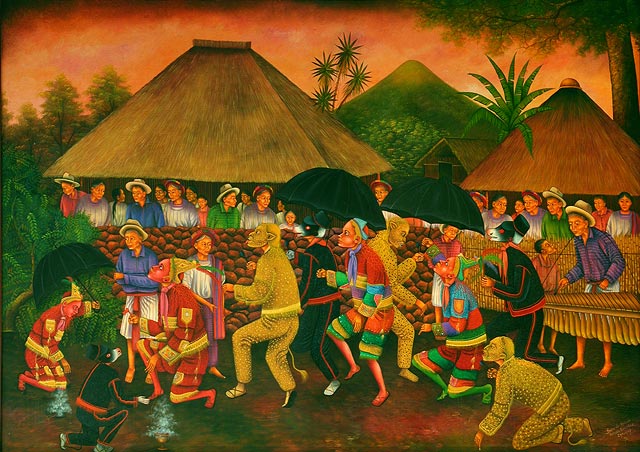

Baile de Naguál
(Dance of the Animal Spirits)
1992
37" x 52", oil on canvas
Mariano Gonzalez Chavajay
Originality: Mariano borrowed this theme from a painting by his cousin Pedro Rafael Gonzalez Chavajay
It is traditional for all Mayan communities to perform masked dances at their festivals, especially the festival day for their town. This particular dance is the Baile de Nahual or dance of the animal spirits. From what I have been told and read, never having seen it performed, during the dance the dancers become possessed by the spirit of their animal counterpart known as a Nahual. There is a folk tale about a hunter who goes to the mountain and encounters a tiger whom he kills, and returning home he finds out it was the Nahual of his young son who had died at the same instant. This dance has its roots in the pre-conquest traditions of the Mayans. In his 1648 book, the Englishman Thomas Gage describes a dance from which the modern day Baile de Nahual and Deer Dance could have descended. "These dancers are all clothed like Beasts , with painted skins of Lions, Tigers, or Wolves, and on their heads such pieces as may represent the heads of such Beasts...." After the Conquest zealous Christians banned indigenous dances, and those that survived incorporated Christian elements. Besides the animals Mariano painted four elaborately dressed dancers who represent Spaniards. He also added three black umbrellas which were not in Pedro Rafael’s version. Since it does not appear to be raining the inclusion of the umbrellas has always seemed mysterious. Of the Tz’utuhil painters who have visited my house, none have been able to explain the umbrellas. It seems not unlikely that Mariano just like the way they look. The dances are performed in the Mayan languages (this dance we can tell from the traje of the people watching is in Santiago Atitlán so it would be in Tz’utuhil) and this gives the Mayan traditions some protection from many outsiders who only speak Spanish. The stories vary from area to area and town to town, and also evolve over time.